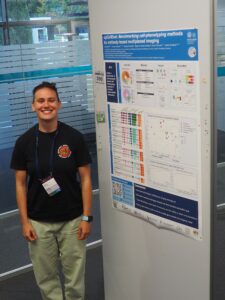Meet the poster prize winners of the EMBL Conference ‘Spatial biology:the melting pot’
The EMBL Conference ‘Spatial biology: the melting pot‘, co-organised with the European Society for Spatial Biology (ESSB), took place in October at EMBL Heidelberg and virtually.
The meeting brought together the rapidly growing spatial biology academic community, fostering discussions on cutting-edge technologies and innovative data analysis approaches. Over four days, renowned speakers with various backgrounds – from medicine, biology, and physics to computer science – presented the latest advances in the field and explored biological systems in health and disease.
We welcomed 480 on-site and 148 virtual participants. After two poster presentation sessions, participants voted for their two favourites among the 182 posters presented. We are pleased to share the abstracts of one of the winners below.
spCellEval (spatial proteomics Cell phenotyping Evaluation): benchmarking cell-phenotyping methods for antibody-based multiplexed imaging
Presenter: Margot Chazotte
Authors: Margot Chazotte, Aroj Hada, Lukas Hatscher, Denis Schapiro, Jovan Tanevski

Heidelberg University, Germany
Abstract:
Accurate cell phenotyping in multiplexed images is crucial for characterising cellular composition within complex tissues and for subsequent downstream analysis. Current techniques, such as manual gating and clustering, rely heavily on expert input, making them time-consuming or highly subjective. Recently, automated algorithms, including Astir, CELESTA, STELLAR, MAPs, etc., have been proposed, each with its own strengths and weaknesses involving their robustness, accuracy, phenotype definitions, and dataset availability. Furthermore, these methods face significant challenges specifically due to imaging noise, segmentation artefacts, and the presence of rare cell types. In this study, we present spCellEval, a comprehensive benchmarking analysis of key cell type classification methods using a collection of publicly available datasets over four categories encompassing metrics in label transfer, cell type composition, scalability, and stability. The datasets include multiplexed imaging data with diverse marker combinations and cell type distributions for multiple tissues obtained from multiple platforms, providing a rigorous framework for assessing the different approaches. Our results highlight trade-offs between automation, interpretability, and the ability to detect rare populations. This study provides practical insights for selecting the most suitable phenotyping methods and introduces a standardised dataset to drive future improvements in multiplexed imaging analysis.
The EMBL Conference ‘Spatial biology: the melting pot’ took place from 14 – 17 October 2025 at EMBL Heidelberg Advanced Training Centre and virtually.